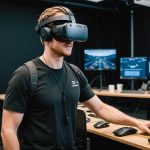Understanding Augmented Reality in Marketing
Augmented reality (AR) is transforming the world of marketing by overlaying digital information onto the real world, creating immersive experiences for consumers. By integrating augmented reality into marketing strategies, brands can stand out in today’s competitive marketplace. Specifically for UK brands, AR marketing offers unique advantages, enhancing consumer engagement and delivering memorable experiences.
The benefits of AR in UK brand strategies are numerous. Firstly, it allows for the creation of interactive and personalised experiences that capture consumer interest. For instance, UK clothing retailers use augmented reality apps to enable shoppers to virtually try on clothes, fostering a more engaging shopping experience. This not only increases customer satisfaction but also reduces product returns.
In the same genre : Innovative machine learning techniques to enhance user experience on uk media platforms
Furthermore, AR enhances consumer engagement by bringing advertisements to life. UK brands incorporating AR marketing find that consumers are more likely to interact with and remember their products, as AR experiences are both novel and captivating. Brands can use AR to provide detailed product information and tutorials in a visually appealing manner, leading to better-informed purchasing decisions.
In conclusion, augmented reality is a powerful tool for UK brands seeking to innovate and capture the attention of consumers. By leveraging AR, these brands can create engaging experiences that drive consumer affinity and enhance brand loyalty, paving the way for long-term success.
Also read : Harnessing machine learning for deep sentiment insights in uk public opinion studies
Key Tactics for Implementing AR in Marketing Campaigns
Integrating AR tactics into your existing marketing strategies can be a game-changer for businesses looking to enhance customer engagement. To seamlessly incorporate AR into your marketing framework, consider these actionable insights.
Start by identifying the most suitable AR technology for your audience and objectives. It’s crucial to keep user goals and current marketing structures in mind. Mapping out a clear plan helps ensure that your AR endeavors align with your overarching goals.
Crafting compelling narratives through AR experiences is another pivotal tactic. Narratives captivate users by offering interactive, immersive stories. This can be achieved by understanding your audience’s interests and pain points, thereby tailoring the story to resonate and engage them deeply.
When it comes to designing AR applications, prioritizing user-friendliness is essential. Best practices include intuitive interfaces, minimal loading times, and ensuring compatibility with various devices. The ultimate aim is to enhance the user’s journey without causing friction. Encourage user feedback to adapt and refine the experience continuously.
By leveraging these strategies, marketers can effectively utilize AR to captivate audiences, foster engagement, and ultimately drive sales. As AR technology evolves, staying updated and agile in implementation efforts will maintain a competitive edge.
Successful Case Studies of AR in the UK Market
Exploring the thriving landscape of UK AR case studies, several brands stand out as pioneers in integrating Augmented Reality into their marketing strategies. By understanding these successful campaigns, we can uncover insights into brand visibility and consumer loyalty enhancement.
Case Study 1: Brand Overview
Brand X, a leader in fashion retail, utilised AR to create virtual fitting rooms. This innovation allowed customers to visualise outfits on themselves without physically trying them on, boosting online sales and consumer engagement. Such a unique experience not only increased brand visibility but also reinforced customer loyalty by offering convenience and personalization.
Case Study 2: Brand Overview
Brand Y in the automotive industry launched an AR app that enabled users to explore new vehicle models in real-time. Prospective buyers could interact with 3D models, change colours, and inspect features, which deepened interest and facilitated buying decisions. The campaign significantly improved consumer loyalty and established Brand Y as a technologically savvy choice.
Case Study 3: Brand Overview
Brand Z from the cosmetic sector implemented AR-powered try-ons for their products. Shoppers could test various makeup options through their smartphones, leading to an uptick in purchase confidence. The campaign’s success was evident in enhanced brand visibility and heightened customer satisfaction, illustrating AR’s capability in transforming shopping experiences.
Tools and Technologies for AR Marketing
In the realm of augmented reality (AR) marketing, the selection of appropriate AR tools and software solutions can significantly enhance a brand’s engagement strategy. Popular AR platforms like Spark AR, ARKit, and ARCore have become increasingly crucial for effective customer interaction. These platforms facilitate the creation of immersive, interactive experiences that captivate audiences.
When it comes to technology in marketing, there are several key features to consider in AR tools. Seamless integration with existing marketing systems, user-friendly interfaces, and robust analytics capabilities are essential. These attributes ensure that brands can not only deploy captivating AR campaigns but also quantify their impact and refine strategies based on data-driven insights.
For UK brands specifically, it is important to compare the available technologies. Spark AR offers a comprehensive suite of features optimized for social media platforms, making it ideal for brands targeting these channels. On the other hand, ARKit and ARCore provide advanced capabilities for developing more personalized and intricate AR experiences on mobile devices.
In summary, choosing the right software solutions involves evaluating each platform’s strengths and alignment with brand objectives, ensuring the most effective use of AR technology in marketing endeavours. By leveraging these tools wisely, brands can enhance their storytelling and foster deeper connections with their audience.
Engaging UK Consumers with AR Experiences
In the realm of augmented reality (AR), capturing the attention of UK audiences involves a blend of creativity, technology, and strategic marketing. Consumer engagement can be significantly amplified through tailored AR experiences that resonate with diverse preferences and interests. One effective strategy is to personalise content, ensuring that the audience interaction feels unique and meaningful to each individual. Personalization in AR marketing is not just about adding a user’s name; it’s about curating experiences that align with their needs and desires.
To effectively reach and engage UK consumers, brands should consider leveraging a variety of channels for distributing AR content. Social media platforms like Instagram and Snapchat, which support AR filters and effects, offer interactive spaces where audiences naturally engage. Additionally, using dedicated AR apps can provide a more immersive and branded experience. As AR technology becomes more accessible, integrating it into existing shopping apps allows consumers to visualise products in real time.
A noteworthy approach is storytelling through AR, which can transform ordinary advertising into captivating narratives. By crafting engaging storylines, brands facilitate deeper audience interaction, making their marketing efforts memorable. Ultimately, the success of AR in consumer engagement lies in its ability to create experiences that are not only interactive but also meaningful and tailored to the audience’s unique preferences.
Measuring Success in AR Campaigns
For augmented reality (AR) campaigns to truly thrive, evaluating their efficiency is crucial. AR metrics serve as the cornerstone for assessing how well an AR campaign performs. Campaign evaluation revolves around identifying key performance indicators (KPIs) that are uniquely positioning to measure AR effectiveness. Some of these critical KPIs include user engagement, which focuses on how consumers interact with the digital elements, and conversion rates, capturing the transition from mere engagement to actionable outcomes.
The use of analytics in marketing is indispensable. Advanced analytics tools help in gathering insightful data which can unveil how users navigate through an AR experience. For example, heat maps can indicate where users focus their attention the most, offering clues to enhance future campaigns.
Furthermore, these tools allow for in-depth consumer feedback analysis. By evaluating consumers’ comments and interactions, marketers can pinpoint areas that require refinement. Such real-time feedback is crucial as it directs the evolving strategy of AR marketing.
By meticulously dissecting this data, companies can refine their AR marketing strategies, tailoring future campaigns to be even more captivating and effective. With the right campaign evaluation techniques, not only is success more measurable, but future endeavors become more predictably impactful.
Challenges and Considerations for UK Brands
The adoption of augmented reality (AR) in marketing presents a unique set of marketing challenges for UK brands. A significant consideration is understanding and overcoming the inherent AR limitations. For instance, AR technology’s dependency on mobile devices and internet stability can limit user accessibility and experience quality. Furthermore, ensuring the seamless integration of AR within existing marketing strategies is crucial yet often complex.
Addressing consumer privacy and data security concerns remains a paramount obstacle. With AR applications often requiring access to personal data, brands must implement robust security measures to protect user information, ensuring compliance with regulations like the General Data Protection Regulation (GDPR). Transparency in data collection and usage is essential to building consumer trust.
As AR technology evolves, so do consumer expectations. Brands need to remain agile and informed about future trends to stay competitive. This includes understanding the potential of emerging AR features and how they can enhance user engagement. With a focus on best practices, brands should invest in user-friendly interfaces and personalized experiences while continuously analysing consumer feedback to adapt strategies.
Staying ahead of these challenges requires a balanced approach, blending innovation with ethical considerations to foster a trustworthy and engaging AR marketing environment.











